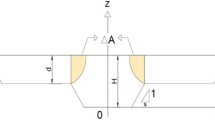Abstract
The momentum transfer phenomenon plays a significant role in complex flow structure in compound channel. It mainly depends upon apparent shear stress at a vertical interface between the main channel and the adjoining floodplains, discharge capacity, and the velocity difference. In the present study, experiments were performed in the asymmetric compound channel to investigate the effect of roughness in floodplain on apparent shear stress distribution and momentum transfer coefficient. The apparent shear stress distribution was calculated using modified equations and momentum coefficient was achieved using Wang–Yang relationship. Furthermore, the conveyance capacity of the asymmetric compound channel was calculated by different 1-D approaches, and it was found that Debord gave minimum root-mean-square error and its values were found to be closest to the actual discharges.
Similar content being viewed by others
References
Sellin, R.H.J.: A Laboratory Investigation into the Interaction Between Flow in the Channel of a River and that of its Flood Plain, La Houille Blanche, No.7, pp.793–801 (1964)
Zheleznyakov, G.V.: Relative deficit of mean velocity of lnstable river flow; kinematic effect in river beds with floodplains. In: Proceedings, 11th International Conference of the lnternational Association for Hydraulic Research, Leningrad, U.S.S, R (1965)
Wang, H.; Yang, K.J.; Cao, S.Y.; Liu, XN.: Computation ofmomentum transfer coefficient and conveyance capacity in compound channels. J. Hydrodyn. Ser. B 19(2), 225–229 (2007). doi:10.1016/s1001-6058(07)60052-3
Patra, K.C.; Khatua K.K.: Apparent Shear Stress in a Compound Channels. HYDRO-2009 CWPRS (2009)
Myers W.R.C.: Momentum transfer in a compound channel. J. Hydraul. Res. 16(2), 139–150 (1978)
Tominaga A., Nezu I.: Turbulent structure in compound open-channel flow. J. Hydraul. Eng. 117(1), 21–41 (1991)
Rajaratnam N., Ahmadi R.: Hydraulics of channels with flood-plains. J. Hydraul. Res. 19(1), 43–60 (1981)
Tang X.N., Knight D.W.: Lateral distributions of streamwise velocity in compound channels and partially vegetated floodplains. Sci. China Ser. E Technol. Sci. 52(11), 3357–3362 (2009)
Rajaratnam, N.; Ahmadi R.M.: Interaction between main channel and floodplains flows. J. Hydraul. Div. ASCE, vol. 105, no. HY5 (1979)
Knight D.W., Demetriou J.D.: Flood plain and main channel flow interaction. J. Hydraul. Eng. ASCE 109(8), 1073–1092 (1993)
Patra, K.C.; Khatua, K.K.: Selection of interface plane in the assessment of discharge in two stage meandering and straight compound channels. In: Proceedings of the International Conference on Fluvial Hydraulics, pp. 379–387. Lisbon (2006)
Chow, V.T.: Open-channel hydraulics. Mc. Graw-Hill Book Co, New York. Hydraul. Eng. 137(8), 815–824 (1959)
van Prooijen B.C., Battjes J.A., Uijttewaal W.S.: Momentum exchange in straight uniform compound channel flow. J. Hydraul. Eng. ASCE 131(3), 175–183 (2005)
Wang D., Cheng L.: Numerical modeling of compound channel flows. J. Hydrodyn. 14(4), 106–109 (2002)
Yang K., Cao S., Liu X.: Research on system dynamics model of conveyance capacity in symmetric compound channels. J. Hydrodyn. 17(3), 295–300 (2005)
Bousmar D., Zech Y.: Momentum transfer for practical flow computation in compound channels. J. Hydraul. Eng. 125(7), 696–706 (2004)
Weber, J. F.; Menéndez, H.: A performance of lateral velocity distribution models for compound channel sections. In: River Flow 2004, Proceedings of International Conference on Fluvial Hydraulics, vol. I, Balkema, Rotterdam, the Netherlands, pp. 449–457 (2004)
Brunner, G.W.: HECRAS-River Analysis System, Hydraulic Reference Manual, version 4.0, U.S Army Corps of Engineers, Hydrologic Engineering Center, Davis, California (2008)
Huthoff F., Roos P.C., Augustijn D.C.M., Hulscher S.J.: Interacting divided channel method for compound channel flow. J. Hydraul. Eng. 134(8), 1158–1165 (2008)
Seç kin G.: A comparison of one-dimensional methods for estimating discharge capacity of straight compound channels. Can. J. Civ. Eng. 31(4), 619–631 (2004)
Ackers P.: Flow formulae for straight two-stage channels. J. Hydraul. Res. 31(4), 509–531 (1993)
Hosseini, S.M.: Equations for discharge calculation in compound channels having homogeneous roughness. Iranian J. Sci. Technol. Transac. B 28(B5) (2004)
Nicollet, G., Uan, M.: Ecoulements à surface libre en lits composés (Free surface flow in compound channels). La Houille Blanche no. 1, pp. 21–30 (1979)
Ackers, P.: Hydraulic design of straight compound channels. Report SR 281, 1, 1–131 and 2, 1–139, HR Wallingford, UK (1991)
Ackers, P.: Hydraulic design of two stage channels. In: Proceedings of the Institution of Civil Engineers Water, Marit and Energy, 96, December paper no. 9988, pp. 247–257 (1992)
Al-Khatib I.A., Dweik A.A., Gogus M.: Evaluation of separate channel methods for discharge computation in asymmetric compound channels. Flow Meas. Instrum. 24, 19–25 (2014)
Khatua, K.K.; Patra, K.C.; Jha, R.: Apparent Shear Stress in a Compound Channel. HYDRO-2009, CWPRS (2009)
Khatua, K.K.; Patra, K.C.: Boundary shear stress distribution in meandering compound channel flow. In: Proceedings of the 5th Australian Stream Management Conference, Albury, NSW, Australia (2007)
Author information
Authors and Affiliations
Corresponding author
Rights and permissions
About this article
Cite this article
Farooq, R., Ahmad, W., Hashmi, H.N. et al. Computation of Momentum Transfer Coefficient and Conveyance Capacity in Asymmetric Compound Channel. Arab J Sci Eng 41, 4225–4234 (2016). https://doi.org/10.1007/s13369-016-2173-8
Received:
Accepted:
Published:
Issue Date:
DOI: https://doi.org/10.1007/s13369-016-2173-8




